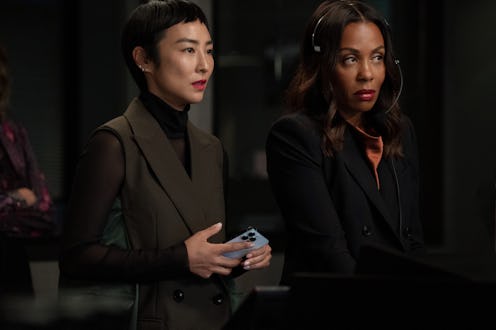(Television)
How The Morning Show Is Shifting Perception On The Drab Corporate Suit
Female characters that look powerful and feminine.

One thing’s clear when watching Season 3 of Apple TV+ series The Morning Show. The female characters deftly navigate the power dynamics of a high pressure, political environment all while dressed in workwear that fits like second skin. From Alex Levy (played by Jennifer Aniston) in a pinstripe, double-breasted blazer to Bradley Jackson (played by Reese Witherspoon) wearing navy, ‘70s flared pants, women in finely tailored pieces define the series. Moreover, the suiting shows just how far the look has evolved from ill-fitting and drab options of yesteryear to a range of styles that would appeal to the diverse tastes of working women.
“The women need to look good, but it’s about balance, authenticity, and character representation,” says Sophie De Rakoff, costume designer to Witherspoon’s character and head costume designer of Seasons 1 and 2, and three episodes in Season 3. An elusive combination, De Rakoff achieves this through in-depth character examination — looking at each woman’s temperament, job, lifestyle, goals — and thoughtful sourcing.
Strong industry relationships help, too. De Rakoff teamed up with Creative Director Emily Smith of Lafayette 148 on Bradley’s navy suit and Stella Bak’s (played by Greta Lee) non-traditional, lavender two-piece suit for episode nine and eight of Season 3, respectively. “It has to be the right people [when collaborating on wardrobe for the show]. And I know who the right people are and I’ll know immediately. It has to work for the character, for the show, for them, and for us. And we will have to get along and that is when the magic happens and it works.”
And it shows. The synergy off-screen is reflected on-screen, even when you don’t notice it — that’s the point. “When [Bradley] gets to evening news in Season 3, now she has the right to wear the suit. She could step into the power suit and wear what works for her . . . she’s still who she is, she’s just more of an elegant version of it,” explains De Rakoff of the navy custom suit by Lafayette 148. Details like fabric, cut, and fit are subtle yet impactful; you see how Bradley is moving up in her career through her wardrobe choices.
How to capture this “elegant version” of a blazer and trousers De Rakoff refers to is the tricky part for many. Maintaining one’s identity while dressing for the job is a common conundrum. But it’s also what makes this show resonate with females in the workforce who are experiencing similar dynamics in the office. The suit serves as an opportunity for women to look and feel powerful, and the wardrobe choices for this particular cast signifies power dressing not centered on what a man would wear in a high-level position, but rather what a woman would while maintaining her femininity.
Case in point: Stella’s aforementioned lavender suit. An unorthodox color choice for an executive, Stella’s outfit speaks to her risk-taking nature and ease as a woman in a position of power. De Rakoff points out that of the entire cast, Stella is the only character that would wear that color. “Stella wears the putties, she wears the greys, she wears the lavender. She is the person who mixes all that up because she does whatever she wants. And Greta Lee is a person who can carry that. She can wear it, and that was a no-brainer.”
This also hold true for Aniston’s character, Alex, whose wardrobe is managed by costume designer Debra McGuire. Her confidence is on sartorial display through her workwear choices. With an emphasis on sleeveless tops and form-fitted pieces, she imbues sophistication and power without concealing her femininity. She sticks to classic cuts and a neutral palette, but the richness in fabric and tailoring reflect the high-level position she’s in. For the fashion-loving viewers, Celine bags make an appearance now and then, and that plays into the character’s proclivity towards luxury fashion with items that work for her lifestyle, not based on trends.
Smith sums up the balance between professionalism and personal style well. “It’s not a man’s gaze on what a tailored suit should look like,” she says, explaining her approach to design. “It’s our gaze.” This perspective enforces that agency is given to women when deciding what to wear and how to wear it, especially in a corporate environment. And with brands like Lafayette 148, the women’s suiting category is finally an equal contender to men’s. Long gone are the days of dull, boring suits.
This article was originally published on